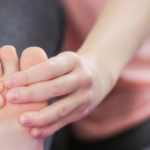
10 Things Your Feet Say About Your Health
There are a quarter of your body’s bones in your feet. There are also 33 joints, 100 tendons, muscles and ligaments, and numerous nerves and blood vessels in each foot. These all link back to the heart, spine and brain. No wonder you can tell so much about your health just by examining your feet.
1. Poor circulation
Poor circulation can be indicated by a number of factors. It may sound strange but hairless feet or toes is an indicator of poor circulation which can be caused by vascular disease. Simply speaking, the body has to prioritise what it does and how it pumps blood to the extremities. Feet are quite low down (excuse the pun) on the totem pole.
Cold feet may also be an indicator of poor blood flow. But remember, while circulatory problems can result in cold limbs, it can actually be a sign of a much larger problem, such as thyroid issues (especially in women).
2. Strange toenails
Toenails with indentations are a sure-sign of anemia, otherwise known as iron deficiency. The condition can show can as an unnatural, concave or spoon-like shape of the nail beds. The reason this happens is because the body doesn’t have enough hemoglobin which transports oxygen. Basically, your toenails aren’t getting enough oxygen.
3. Sore big toes
A big toe that presents as swollen, sore, and red could be a sign of gout. Fact of the matter is that it’s usually the first sign of gout – and it’s a sore big toe that a person first notices. Gout is a form of arthritis and is caused by elevated levels of uric acid in the bloodstream. The buildup of uric acid forms in the limbs with the lowest temperatures, which is why the big toe is the most common place gout can form – it’s the farthest part of the body from the heart. Importantly, you don’t have to be over 65 to get it, which is a common misconception.
4. Cramping in your feet
Sudden onset cramping may be nothing to worry about. The contraction of a muscle can often be triggered by exercise or dehydration. A simple stretch and some water may straighten it right out. However, constant cramping can be caused by an insufficient diet, especially calcium, potassium or magnesium.
5. Sores on the bottom of the feet
Sores that won’t heal are a major hint of diabetes. Nerve damage in the feet can be caused by elevated blood glucose levels, meaning that minor scrapes, cuts or grazes can fester, especially those that can go unnoticed like the ones on your feet. It’s crucial to treat these as soon as possible because if untreated, it can lead to infection.
6. Dry skin
Athlete’s foot is often associated with athletes. But you don’t have to be a big exerciser to actually get it. Dry, itchy and flaky skin, especially between the toes can be a sign of the fungal infection. Athlete’s foot festers in warm, dark and moist environments which is why it often presents between the toes or under the foot. The dry skin can mean it can get itchy, burn and peel and it can sometimes also cause a slight odor. It can be treated by over-the-counter antifungal creams or sprays.
7. Pins and needles
Numbness in the feet or a constant feeling of pins and needles can actually be damage to the peripheral nervous system – the body’s way of talking between the brain, the spinal cord and the rest of the body. The top two causes for peripheral neuropathy are diabetes and alcohol abuse.
8. Foot drop or drop foot
If you can’t raise your foot upward from the heel, there may be some nerve or muscle damage present. And the damage, believe it or not, may not even be in your foot. Nerve or muscle damage can originate as far up as your back, shoulder or neck and still impact your feet.
9. Red, white or blue toes
If your toes are turning funny colours, it may be Raynaud’s disease. The disease, caused by the narrowing of the arteries, causes toes to turn white and then blue before reddening a bit and returning to their natural colour. Stress or sudden changes in temperature may be the trigger but Raynaud’s disease can also be linked to rheumatoid arthritis or thyroid problems.
10. Shooting pain in your heel
Plantar fasciitis is the inflammation of the connective tissue that runs along the bottom of the foot, causing the tissue to strain beyond what it can normally. The pain will often start when you first get up in the morning and will intensify as the day wears on. While you’ll generally feel it in the heel, the pain can also be felt in the arch of the foot so make sure your feet are supported with good shoes.
Need some help figuring out what’s going on with your feet? Miracle Therapy, Local Podiatry and Gungahlin Medical Practice can help!

